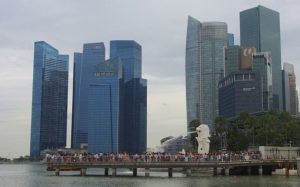 The Ministry of Trade and Industry (MTI) has narrowed Singapore’s GDP growth forecast for 2016 to 1.0% to 2.0% from the earlier 1.0% to 3.0% in line with projected lackluster global growth and heightened downside risks.
The Ministry of Trade and Industry (MTI) has narrowed Singapore’s GDP growth forecast for 2016 to 1.0% to 2.0% from the earlier 1.0% to 3.0% in line with projected lackluster global growth and heightened downside risks.
The lower ceiling for the new forecast stems from a slightly weakened global economic outlook since three months ago in May following Britain’s referendum outcome in June favoring its exit from the EU, which has “dampened and also added uncertainties to the global growth outlook,” said MTI in an official statement.
“In line with this, most key economies, except for the US, are expected to see similar or slower growth in the second half of the year as compared to the first half of the year,” it added.
It said the U.S. economy, which grew modestly in the second quarter following the weak growth momentum in the first quarter, is expected to pick up in the remaining quarters of the year, supported by domestic demand.
But in the UK, while growth picked up in the second quarter, the country is expected to experience a slowdown in the second half of the year, with the uncertainties associated with Brexit weighing on investments and consumption. For the Eurozone, full-year growth is likely to remain modest and come in slightly lower compared to 2015.
In Asia, meanwhile, China’s overall growth is expected to slow in the second half of the year relative to the first half, with full-year growth projected to be lower than in 2015. In the ASEAN region, growth in the Indonesian and Malaysian economies in the second half of the year is expected to be broadly similar to that in the first half, supported by resilient domestic demand.
In general, MTI said, “additional downside risks in the global economy remain.” If the impact of Brexit on consumer and business confidence is more severe than expected, “there could be a sharp pullback in consumption and investments, which could in turn lead to a further slowdown in economic growth.”
Moreover, amidst rising corporate credit levels in China, there is a risk that debt defaults could spike as the economy continues to restructure, thus leading to a tightening of financial conditions. “If this materializes, the Chinese economy could slow down more sharply than expected,” the agency said.
The outlook revision came as MTI reported on the republic’s economic performance in the second quarter, which grew by just 2.1% year-on-year, unchanged from the first quarter. On a quarter-on-quarter seasonally adjusted annualized basis, the economy expanded by 0.3%, slightly faster than the 0.1% growth in the preceding quarter.
The manufacturing sector expanded by 1.1% year-on-year, a reversal from the 0.5% decline in the previous quarter, while the construction sector moderated to 3.3% year-on-year from 4.0% in the first quarter.
The wholesale & retail trade sector expanded by 2.2% year-on-year, a pullback compared to the 2.9% growth in the previous quarter.
The transportation & storage sector grew by 2.9% year-on-year, an improvement from the 0.1% contraction in the previous quarter.
The accommodation & food services sector registered growth of 1.6% on a year-on-year basis, similar to the 1.7% expansion in the previous quarter, and the information & communications sector expanded by 1.2% year-on-year, as compared to the 3.1% growth in the previous quarter.
The finance & insurance sector grew by 0.8% year-on-year, slowing from the 2.7% growth in the previous quarter. The business services sector, meantime, recorded a slight contraction of 0.2% year-on-year compared to the 0.1% growth in the first quarter. Growth in the “other services industries” came in at 1.6% year-on-year, higher than the 0.8% in the previous quarter.





